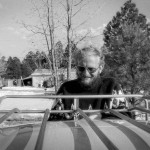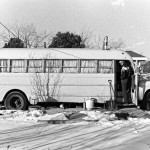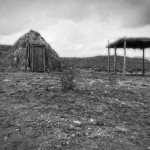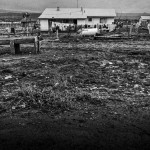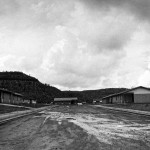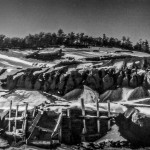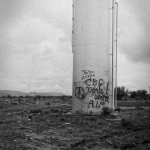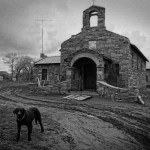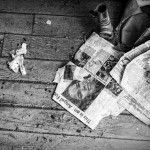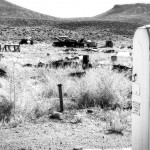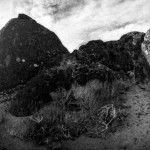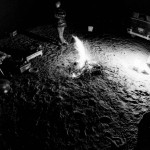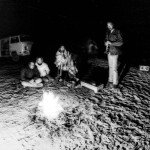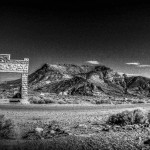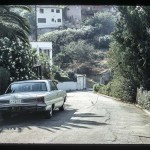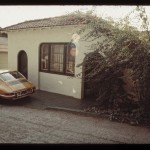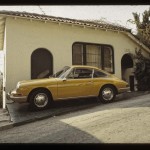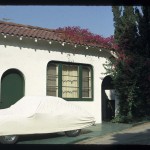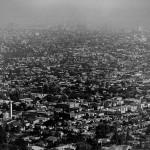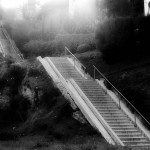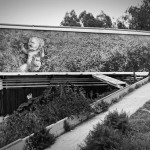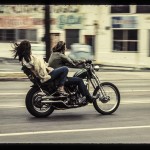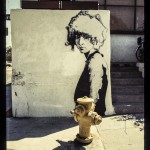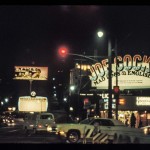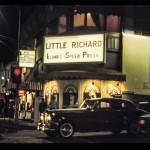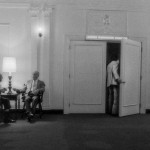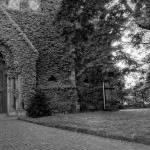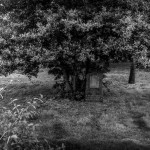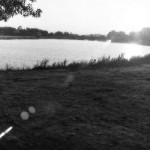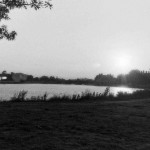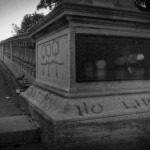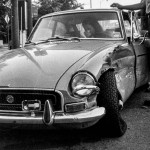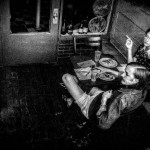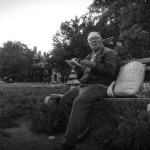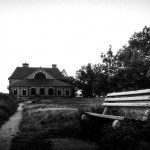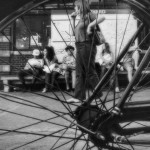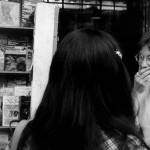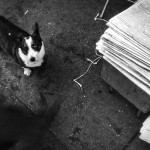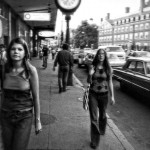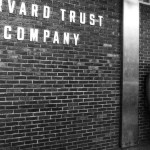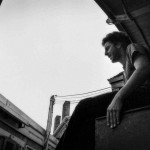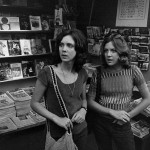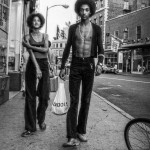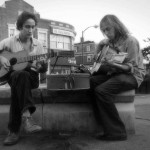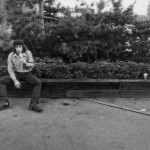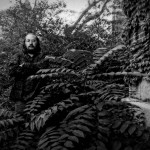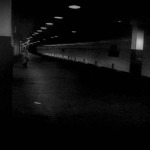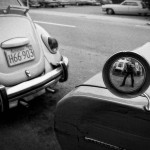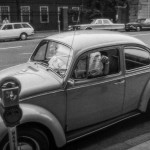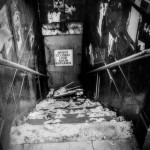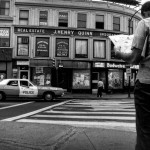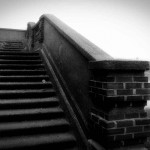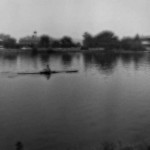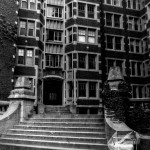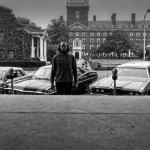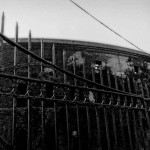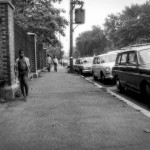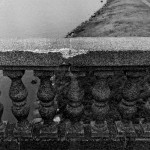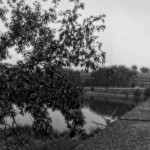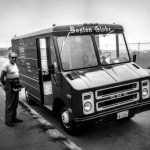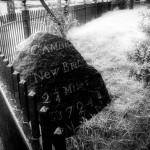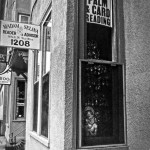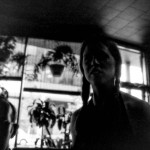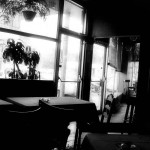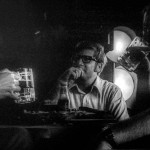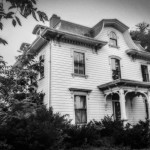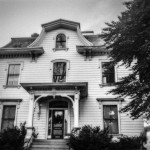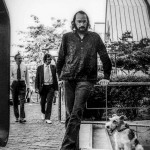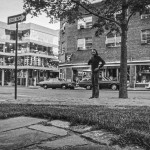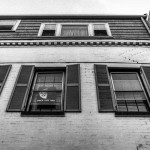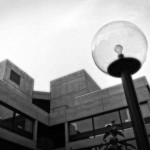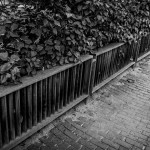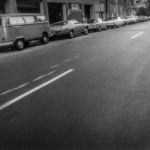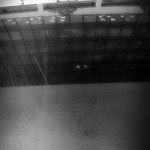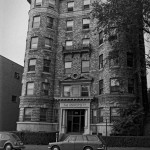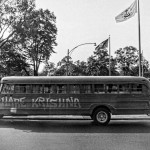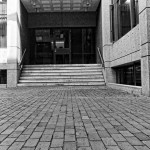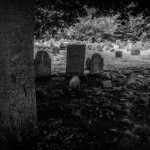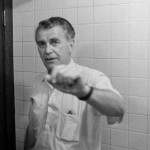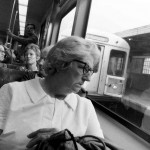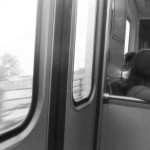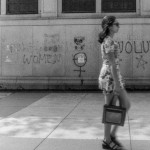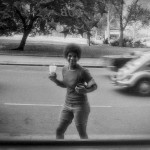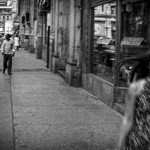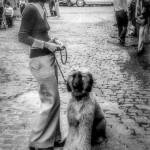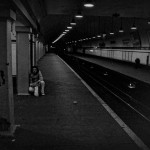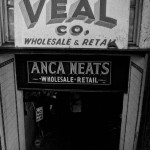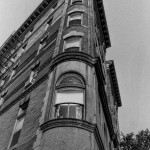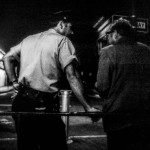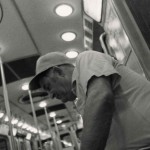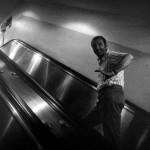Earlier, in describing my year or so with the White Mountain Apaches, I mentioned my friend Chris (mountain man/ski bum/engineer/fellow Porsche enthusiast/Popeye impersonator). He and his girlfriend lived in a schoolbus near the Reservation and near my cabin. Some pics I stumbled upon this weekend:
Category: early b&w
In the White Mountains of Arizona (1972-74): Part Four
About six or eight weeks ago, I began unearthing negatives from my stint with the White Mountain Apaches (see the Introduction here). This weekend I came upon a few more images of Reservation scenes. These include photos of housing, ranging from the traditional wickiup (“wigwam” in white-speak — note that the example here has been fitted with a modern door) to government housing tracts (ranging from mid-20th-century to then-recent developments) to scattered houses and cabins and shelters of all sorts. Some dwellings from the 19th century, and perhaps older, were constructed with short rock walls extending down into the earth to create a semi-underground shelter with a roof of whatever material was at hand; I should be able to eventually find some photos of these ( I even met and visited a tribal member who returned to the reservation after gaining a law degree and refurbished one such shelter for his own private home) . Also, we can see evidence of AIM (American Indian Movement; remember Dennis Banks and Russell Means?) activism. The graffiti lettering “CBQ” refers to the poverty-stricken reservation community of Cibecue, incidentally.
Previous:
Intro
Part One
Part Two
Part Three
Death Valley Redux, 1972
A couple of trips in wintertime …
More Death Valley …
http://whilebusy.com/2015/11/15/death-valley-thanksgiving-1971/
http://whilebusy.com/2015/11/20/yet-another-d-v-trek/
http://whilebusy.com/2015/11/16/california-nevada-desert-circa-1972-73/
More From The LA Past, Circa 1970 (Kodachrome, too)
From about 1969-71, I lived just off Sunset Boulevard high up a ridge or cliff overlooking the street, and at the southern edge of the Silverlake district.
My house, on Hamilton Way, would have been one of my favorites, ever, if it hadn’t been for my very unpleasant landlady (what did we call her? “Bertha Brittle” or something like that), but she was an infrequent annoyance as she was mostly out of sight and rarely visited from the west side of L.A.
The place looked tiny from streetside, but plunged down the cliff on the opposite side for three levels into a clearing surrounded by dense brush, with Sunset Blvd. level shops far below that, feeling quite remote from any neighbors. It had been converted for duplex use, and the bottom floor was occupied by a couple who would become fast friends. My portion consisted in part of a top floor at street level which had suffered structural damage in an earthquake* — said to have occurred in the late 30s — resulting in a sloping floor that made normal use almost impossible. I turned it into a slanted, furniture-free gallery, with a small darkroom at one side equipped with tables of unequal length legs to create a level working surface. The second level, entered from steps behind heavy foliage going down the hillside, consisted of a sizable entry hall with the kitchen to the left/east (which had an internal short staircase to the slanting top level), a bedroom to the right/west, a narrow bathroom alongside at the right but deeper inside, and a central opening to a large living room the width of the entire place (similar in aspect ratio, but a bit larger, to the 1005 drop-level living space, if you have visited us in this century) that had full-height windows and doors to a deck on the south, and full-width windows on the east end.
In this “sunroom” (of course, I really wanted a northlit space, but those were hard to find), I set up a shooting studio, my stereo system, some bookshelves and little else. Outside the south-facing doors was a nearly-full-width deck which hung over the cliff and allowed everything from Sunset Blvd. traffic watching to nude sunbathing to sunset/sunrise and night cityscape viewing. Wood floors throughout were in fairly good condition, but the exterior stucco was crumbling. I considered buying the house at one point, but the costs to repair the upper foundation were alarming.
(*I memorably experienced the 6.7 or whatever it was 1971 San Fernando earthquake early one pre-dawn morning there and also lived there as I quit smoking, cold-turkey, in one of the most difficult ordeals I can recall. And during that period I encountered a number of extraordinary people who figured in my life for some time to come, and who will probably be present in photos yet to be unearthed.)
Some other views from that neighborhood, and at least one from the deck:
Many hours were spent walking along Sunset and Hollywood Boulevards, not to mention driving around the hills of Silverlake. (I recall timed runs around the Silverlake Reservoir, and driving up hills so steep that the steering of my rearward-weight-biased Porsche became very light and little more than the sky could be seen through the windshield. Pretty scary.) In the 60s, both before and after my VietNam stint, I lived in Hollywood, often walking and photographing and watching films on Hollywood Blvd. After I moved to the hills above Sunset, I continued to return to that area as well, frequenting jazz clubs, movie theatres and bookstores, but also exploring eastward into the Armenian and Latino areas, and into downtown. Some photos from the streets …
More for the Gabrielle Collection
Today, with the holidays in the rear view mirror and still unable to see my way clear for a new camera to resume new work, I return to the ancient archives of unpublished and unseen stuff from the 60s and 70s. Here’s the young Gabrielle, somewhere around 1969 or 1970.
Easter Sunday, Venice, 1972
Or at least that was how this batch of old negatives was marked …
Los Angeles, 1972: Alvarado and MacArthur Park
One early spring day in 1964 I packed my possessions — barely more than clothes, a portable record player, a box of vinyl albums and a clock radio — into my 1953 Ford Tudor (that’s how they spelled it) and left Iowa, driving pretty much straight through to Los Angeles, stopping only for gas and an hour or two catnap here and there. It was well after midnight when I took an off-ramp to Downtown Los Angeles, having no clue where to go and with an address only for a workplace to which I would report on the forthcoming Monday. I expected to drive around all night to try to get a feel of the place, but exhaustion set in and after a couple of hours came upon a small, rather derelict but friendly motel that seemed to be Latino-managed with me the only gringo in sight. The next morning I awoke, walked around and when I found myself on Alvarado near MacArthur Park and shortly discovered Langer’s deli and its pastrami, I knew that I had arrived in heaven. I stayed there for a few days to get my bearings, checked in later at my work destination (GAO, then on South Broadway) and eventually found permanent residence near Western Avenue.
Almost exactly eight years later, I seem to have photographed a bit of that old neighborhood (I frequently revisited Langer’s — as well as the wonderful 24-hour Canter’s deli in West Hollywood and a couple of other fine Jewish delicatessens in the S.F. Valley and elsewhere, just to digress) probably while going for a pastrami sandwich. These otherwise banal, undistinguished photos may give you a little sense of the area.
I also uncovered a few more photos, these dated 4/22/72, which appear to picture a VietNam protest rally at what I think would be the same MacArthur Park locale and timeframe.
Boston, 1972: Part Four
Previously …
Part One
Part Two
Part Three
Boston, 1972: Part Three
Boston, 1972: Part Two
Night time was the hardest to shoot, but probably the most interesting time to explore this (or most any other) city. Self-portraits occur from time to time, demanded by my girlfriend — herself a photographer — back in LA. My experience in Boston contrasted starkly with, say, New York, in that people on the street (police included) were very friendly and often struck up conversation.


